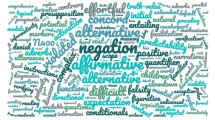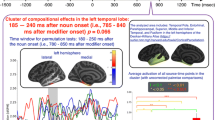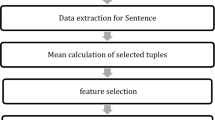Abstract
The processing of sentences with negative quantifiers (e.g., few) is more costly than of sentences that contain their positive counterparts (e.g., many). While this polarity effect is robust and reliably replicable, its neurological bases are not well understood. In this study, we use functional magnetic resonance imaging (fMRI) paradigm for 30 participants to assess the polarity effect in sentences with polar quantifiers, and compare it with the polarity effect of polar adjectives. Both in quantifiers and in adjectives, the polarity effect manifests in the anterior insula bilaterally. The polarity effect in quantifiers, however, shows greater activation in the left hemisphere than it does for adjectives. In particular, left inferior frontal gyrus (IFG) and left superior temporal sulcus (STS) show increased activation for polarity in quantifiers than in adjectives, which is the evidence for the specific involvement of the language network in this type of polarity processing. Using the polarity effect in adjectives as a control, we provide further evidence for the linguistic complexity that negative quantifiers implicate on processing.



Similar content being viewed by others
Data availability
All data generated and/or analyzed in this study are available on request from the corresponding author.
Notes
We use the term "negativity" here in a rather loose way. It is beyond the scope of this paper to discuss in full what "negativity" means. For our purposes it is sufficient to convince the reader that few has a negative flavor, and is used similarly to negation, in a sharp contrast with a small number, despite the superficial similarity between the two.
Although the cluster in the left IFG+insula showed greater activation for quantifiers than for adjectives in the ROI analysis, our cluster analysis revealed that only the left IFG was significant for the Polarity×Type interaction, and not the insula. This was corroborated by an additional analysis in which we smaller ROIs of the insulas only. Indeed, we found no Polarity×Type interaction in the insula in that analysis.
References
Agmon G, Loewenstein Y, Grodzinsky Y (2019) Measuring the cognitive cost of downward monotonicity by controlling for negative polarity. Glossa J Gen Linguist 4:36. https://doi.org/10.5334/gjgl.770
Alain C, Du Y, Bernstein LJ et al (2018) Listening under difficult conditions: an activation likelihood estimation meta-analysis. Hum Brain Mapp 39:2695–2709. https://doi.org/10.1002/hbm.24031
Bahlmann J, Müller JL, Makuuchi M, Friederici AD (2011) Perisylvian functional connectivity during processing of sentential negation. Front Psychol 2:104. https://doi.org/10.3389/fpsyg.2011.00104
Bain JS, Yeatman JD, Schurr R et al (2019) Evaluating arcuate fasciculus laterality measurements across dataset and tractography pipelines. Hum Brain Mapp 40:3695–3711. https://doi.org/10.1002/hbm.24626
Barwise J, Cooper R (1981) Generalized quantifiers and natural language. Linguist Philos 4:159–219
Bates D, Maechler M, Bolker B, Walker S (2015) Fitting linear mixed-effects models using lme4. J Stat Softw 67:1–48. https://doi.org/10.18637/jss.v067.i01
Bott O, Schlotterbeck F, Klein U (2018) Empty-set effects in quantifier interpretation. J Semant 36:1–65
Büring D (2009) More or less. In: Elliot M, Kirby J, Sawada O (eds) Proceedings from the annual meeting of the Chicago Linguistic Society. Chicago Linguistic Society, USA, pp 3–17
Carpenter PA, Just MA, Keller TA et al (1999) Time course of fMRI-activation in language and spatial networks during sentence comprehension. Neuroimage 10:216–224. https://doi.org/10.1006/nimg.1999.0465
Catani M, Allin MPG, Husain M et al (2007) Symmetries in human brain language pathways correlate with verbal recall. ProcNatlAcadSci USA 104:17163–17168. https://doi.org/10.1073/pnas.0702116104
Christensen KR (2009) Negative and affirmative sentences increase activation in different areas in the brain. J Neurolinguistics 22:1–17. https://doi.org/10.1016/j.jneuroling.2008.05.001
Cox RW (1996) AFNI: Software for analysis and visualization of functional magnetic resonance neuroimages. Comput Biomed Res 29:162–173. https://doi.org/10.1006/CBMR.1996.0014
Deschamps I, Agmon G, Loewenstein Y, Grodzinsky Y (2015) The processing of polar quantifiers, and numerosity perception. Cognition 143:115–128. https://doi.org/10.1016/j.cognition.2015.06.006
Friederici AD, Gierhan SM (2013) The language network. CurrOpinNeurobiol 23:250–254. https://doi.org/10.1016/j.conb.2012.10.002
Geurts B (1989) Goodness. In: Proceedings of the 17th Amsterdam Colloquium
Grodzinsky Y, Agmon G, Snir K, et al (2018) The processing cost of Downward Entailingness: the representation and verification of comparative constructions. In: Sauerland U, Solt S (eds). Proceedings of Sinn und Bedeutung 22. ZAS, pp 435–451
Grodzinsky Y, Deschamps I, Pieperhoff P et al (2020) Logical negation mapped onto the brain. BrainStructFunct 225:19–31. https://doi.org/10.1007/s00429-019-01975-w
Grodzinsky Y, Behrent K, Agmon G et al (2021) A linguistic complexity pattern that defies aging: the processing of multiple negations. J Neurolinguistics 58:100982. https://doi.org/10.1016/j.jneuroling.2020.100982
Heim I (2006) Little. In: Gibson M, Howell J (eds) Proceedings of semantics and Linguistic Theory (SALT) 16. Cornell University, Ithaca, pp 35–58
Heim S, Amunts K, Drai D et al (2012) The language-number interface in the brain: a complex parametric study of quantifiers and quantities. Front EvolNeurosci 4:4. https://doi.org/10.3389/fnevo.2012.00004
Heim S, McMillan CT, Clark R et al (2016) How the brain learns how few are “many”: An fMRI study of the flexibility of quantifier semantics. Neuroimage 125:45–52. https://doi.org/10.1016/j.neuroimage.2015.10.035
Heim S, Peiseler N, Bekemeier N (2020) “Few” or “many”? An adaptation level theory account for flexibility in quantifier processing. Front Psychol 11:382. https://doi.org/10.3389/fpsyg.2020.00382
Just MA, Carpenter PA (1971) Comprehension of negation with quantification. J Verbal Learn Verbal Behav 10:244–253. https://doi.org/10.1016/S0022-5371(71)80051-8
Klima E (1964) Negation in English. In: The structure of language. pp 246–323
Kumar U, Padakannaya P, Mishra RK, Khetrapal CL (2013) Distinctive neural signatures for negative sentences in Hindi: an fMRI study. Brain Imaging Behav 7:91–101. https://doi.org/10.1007/s11682-012-9198-8
Kuznetsova A, Brockhoff PB, Christensen RHB (2017) lmerTest package: tests in linear mixed effects models. J Stat Softw 82:1–26. https://doi.org/10.18637/jss.v082.i13
Ladusaw WA (1980) On the notion of affective in the analysis of negative-polarity items. J Linguist Res 1:1–16
MATLAB (2017) Version version 9.3.0 (R2017b). The MathWorks Inc., Natick
McMillan CT, Clark R, Moore P et al (2005) Neural basis for generalized quantifier comprehension. Neuropsychologia 43:1729–1737. https://doi.org/10.1016/j.neuropsychologia.2005.02.012
McMillan CT, Coleman D, Clark R et al (2013) Converging evidence for the processing costs associated with ambiguous quantifier comprehension. Front Psychol 4:153. https://doi.org/10.3389/fpsyg.2013.00153
Menon V, Uddin LQ (2010) Saliency, switching, attention and control: a network model of insula function. Brain StructFunct 214:655–667. https://doi.org/10.1007/s00429-010-0262-0
Moxey LM, Sanford AJ (1986) Quantifiers and focus. J Semant 5:189–206. https://doi.org/10.1093/jos/5.3.189
Nelson SM, Dosenbach NUF, Cohen AL et al (2010) Role of the anterior insula in task-level control and focal attention. Brain StructFunct 214:669–680. https://doi.org/10.1007/s00429-010-0260-2
Nucifora PGP, Verma R, Melhem ER et al (2005) Leftward asymmetry in relative fiber density of the arcuate fasciculus. Neuro Rep 16:791–794
Oh A, Duerden EG, Pang EW (2014) The role of the insula in speech and language processing. Brain Lang 135:96–103. https://doi.org/10.1016/j.bandl.2014.06.003
Penka D (2011) Chapter 4: Scope splitting with other downward-entailing quantifiers. In: Negative indefinites. Oxford University Press, Oxford
Pezzelle S, Bernardi R, Piazza M (2018) Probing the mental representation of quantifiers. Cognition 181:117–126. https://doi.org/10.1016/j.cognition.2018.08.009
Sanford AJ, Dawydiak EJ, Moxey LM (2007) A unified account of quantifier perspective effects in discourse. Discourse Process 44:1–32. https://doi.org/10.1080/01638530701285556
Satterthwaite FE (1946) An approximate distribution of estimates of variance components. Biom Bull 2:110–110. https://doi.org/10.2307/3002019
Shikhare S, Heim S, Klein E et al (2015) Processing of numerical and proportional quantifiers. CognSci 39:1504–1536. https://doi.org/10.1111/cogs.12219
Siegel JS, Power JD, Dubis JW et al (2014) Statistical improvements in functional magnetic resonance imaging analyses produced by censoring high-motion data points. Hum Brain Mapp 35:1981–1996. https://doi.org/10.1002/hbm.22307
Stoodley CJ, Schmahmann JD (2009) Functional topography in the human cerebellum: a meta-analysis of neuroimaging studies. Neuroimage 44:489–501. https://doi.org/10.1016/J.NEUROIMAGE.2008.08.039
Su M, de Schotten MT, Zhao J et al (2018) Vocabulary growth rate from preschool to school-age years is reflected in the connectivity of the arcuate fasciculus in 14-year-old children. Dev Sci 21:e12647. https://doi.org/10.1111/desc.12647
Szymanik J, Zajenkowski M (2013) Monotonicity has only a relative effect on the complexity of quantifier verification. In: Aloni M, Franke M, Roelofsen F (eds) Proceedings of the 19th Amsterdam Colloquium. University of Amsterdam, ILLC, pp 219–225
Tettamanti M, Manenti R, Della Rosa PA et al (2008) Negation in the brain: modulating action representations. Neuroimage 43:358–367. https://doi.org/10.1016/j.neuroimage.2008.08.004
Thiebaut de Schotten M, Ffytche DH, Bizzi A et al (2011) Atlasing location, asymmetry and inter-subject variability of white matter tracts in the human brain with MR diffusion tractography. Neuroimage 54:49–59. https://doi.org/10.1016/j.neuroimage.2010.07.055
Tournier J-D, Calamante F, Connelly A (2012) MRtrix: diffusion tractography in crossing fiber regions. Int J Imaging SystTechnol 22:53–66. https://doi.org/10.1002/ima.22005
Touroutoglou A, Hollenbeck M, Dickerson BC, Feldman Barrett L (2012) Dissociable large-scale networks anchored in the right anterior insula subserve affective experience and attention. Neuroimage 60:1947–1958. https://doi.org/10.1016/j.neuroimage.2012.02.012
Troiani V, Peelle JE, Clark R, Grossman M (2009) Is it logical to count on quantifiers? Dissociable neural networks underlying numerical and logical quantifiers. Neuropsychologia 47:104–111. https://doi.org/10.1016/j.neuropsychologia.2008.08.015
Tucker D, Tomaszewicz B, Wellwood A (2018) Decomposition and processing of negative adjectival comparatives. In: Castroviejo E, McNally L, Weidman Sassoon G (eds) The semantics of gradability, vagueness, and scale structure: experimental perspectives. Springer, Cham, pp 243–273
van Assen MALM, van Aert RCM, Nuijten MB, Wicherts JM (2014) Why publishing everything is more effective than selective publishing of statistically significant results. PLoS ONE 9:e84896. https://doi.org/10.1371/journal.pone.0084896
van Maanen L, Forstmann BU, Keuken MC et al (2016) The impact of MRI scanner environment on perceptual decision-making. Behav Res Methods 48:184–200. https://doi.org/10.3758/s13428-015-0563-6
Vandermosten M, Boets B, Poelmans H et al (2012) A tractography study in dyslexia: neuroanatomic correlates of orthographic, phonological and speech processing. Brain J Neurol 135:935–948. https://doi.org/10.1093/brain/awr363
Ward BD (1998) Deconvolution analysis of fMRI time series data: documentation for the AFNI software package. NatlInst Health Bethesda MD 2:2
Xiang M, Grove J, Giannakidou A (2016) Semantic and pragmatic processes in the comprehension of negation: an event related potential study of negative polarity sensitivity. J Neurolinguistics 38:71–88. https://doi.org/10.1016/j.jneuroling.2015.11.001
Yeatman JD, Dougherty RF, Myall NJ et al (2012) Tract profiles of white matter properties: automating fiber-tract quantification. PLoS ONE 7:e49790. https://doi.org/10.1371/journal.pone.0049790
Zaccarella E, Friederici AD (2015) Reflections of word processing in the insular cortex: a sub-regional parcellation based functional assessment. Brain Lang 142:1–7. https://doi.org/10.1016/j.bandl.2014.12.006
Acknowledgements
We would like to thank Yosef Grodzinsky, Aviv Mezer and Michal Ben-Shachar for their helpful comments, support and advice. This work was funded by the United States-Israel Binational Science Foundation (BCS1551330) and the Israel Science Foundation (0399306 and 2093/16).
Funding
This work was supported by the United States-Israel Binational Science Foundation (BCS1551330) and the Israel Science Foundation (0399306 and 2093/16).
Author information
Authors and Affiliations
Contributions
Conceptualization: GA, ID; investigation: GA, JSB; formal analysis: GA, JSB, ID; writing—original draft preparation: GA, JSB; writing—review and editing: GA, JSB, ID.
Corresponding author
Ethics declarations
Conflict of interest
On behalf of all authors, the corresponding author states that there is no conflict of interest.
Research involving human participants and/or animals
All procedures performed in studies involving human participants were in accordance with the ethical standards of the institutional and/or national research committee and with the 1964 Helsinki declaration and its later amendments or comparable ethical standards. This article does not contain any studies with animals performed by any of the authors.
Informed consent
Informed consent was obtained from all individual participants included in the study.
Additional information
Communicated by Melvyn A. Goodale.
Publisher's Note
Springer Nature remains neutral with regard to jurisdictional claims in published maps and institutional affiliations.
Electronic supplementary material
Below is the link to the electronic supplementary material.
Appendix
Appendix
In the main text we illustrate different facets of the Polarity effect through the modality of fMRI. However, we also collected diffusion MRI (dMRI) data from our participants, with a goal of quantifying the relationship of two MRI modalities vis a vis the Polarity effect and hemispheric laterality. We did not find any relationship between the Polarity effect and white-matter pathways. Yet, we report here the dMRI analysis and results due to the importance of publishing also null results (van Assen et al. 2014).
Specifically, we used the dMRI data to identify the arcuate fasciculus, a white-matter pathway known to be important for language and which is known to be left lateralized (Nucifora et al. 2005; Thiebaut de Schotten et al. 2011; Bain et al. 2019). We hypothesized that arcuate asymmetry (dMRI) would correlate with activation asymmetry (fMRI) as well as with the Polarity effect (behavior). We also used the dMRI data to identify the uncinate fasciculus as a control fascicle.
The dMRI data were collected in the same session as the fMRI data (see below for data collection and processing specifics). We identified the arcuate and uncinate for our subjects (example in Fig.
Relating dMRI asymmetry and polarity measurements. a Left hemisphere of a sample subject showing the arcuate (blue) and uncinate (pink) fasciculi. b The laterality index (L.I.) of the arcuate fasciculus shows a positive correlation with the ΔRT = (\(\frac{{\mathrm{RT}}_{\mathrm{neg}}-{\mathrm{RT}}_{\mathrm{pos}}}{\stackrel{-}{\mathrm{RT}}}\)), though not significant: r = 0.2, p = 0.2. c Taking the uncinate fasciculus as a control region, we show no correlation of the L.I. of the uncinate fasciculus with the ΔRT. d Taking the RT as a control, we find no correlation between arcuate L.I. and RT
4), and calculated a laterality index (L.I.) for the arcuate and uncinate in each subject. The relationship between arcuate laterality and the polarity effect was non-significant (Fig. 4b). Our controls showed no relationship between uncinate laterality and the polarity effect (Fig. 4c), nor for arcuate laterality and reaction time (Fig. 4d).
dMRI data collection and analysis
Diffusion data were collected with a diffusion-weighted spin-echo echo-planar imaging sequence, with acceleration factor of 3 and partial Fourier of 6/8. Slice thickness was 1.7 mm, field of view 220 × 220 mm2 and matrix size 128 × 128, yielding voxel size 1.7 × 1.7 × 1.7 mm3. The diffusion gradient strength was 45 mT/m and diffusion-weighted gradients were applied for 64 noncollinear directions with b = 2000 s/mm2. The repetition time was 4000 ms and the echo time was 96.2 ms. The total acquisition time was about 5 min.
To analyze the diffusion data, we used the Vistasoft (http://github.com/vistalab/vistasoft/mrDiffusion) and MRtrix (version 0.2.12, https://www.nitrc.org/projects/mrtrix/) software packages. Preprocessing steps include corrections for subject motion and eddy currents. From the preprocessed diffusion data, we created a set of streamlines, called the tractogram, which represents the large white-matter pathways that cover the brain. We computed a whole-brain tractogram using MRtrix with a maximum harmonic order (lmax) of 6, and then generated 500,000 streamlines using the sd_prob method (Tournier et al. 2012). To compute the whole-brain tractogram in MRtrix, we used a white-matter mask as both the seed and mask regions, with the default MRtrix parameters (step size 0.2 mm, curvature radius 1 mm, stopping criterion FA < 0.1).
To extract the arcuate fasciculus from the whole-brain tractogram, we used Matlab (2017) to run the software package Automated Fiber Quantification (AFQ; Yeatman et al. 2012 and https://github.com/yeatmanlab/AFQ). We used the same pipeline to identify the left and right uncinate fasciculi, which we used as a control fascicle. To evaluate fascicle laterality, we counted the streamlines in the left and right fascicle and computed the laterality index, L.I. = (right minus left) ÷ (right plus left), where a positive L.I. indicates rightward laterality and a negative L.I. indicates leftward laterality.
We define \(\Delta RT=\frac{R{T}_{neg}-R{T}_{pos}}{R{T}_{pos}}\), which reflects the percent change in processing time implicated by the negative antonym. We identify a correlation between ΔRT for the two sentence Types (r = 0.59, p = 0.0006), providing further support for our assumption that quantifier negation and adjective negation share to some extent their underlying cognitive mechanisms.
Rights and permissions
About this article
Cite this article
Agmon, G., Bain, J.S. & Deschamps, I. Negative polarity in quantifiers evokes greater activation in language-related regions compared to negative polarity in adjectives. Exp Brain Res 239, 1427–1438 (2021). https://doi.org/10.1007/s00221-021-06067-y
Received:
Accepted:
Published:
Issue Date:
DOI: https://doi.org/10.1007/s00221-021-06067-y





